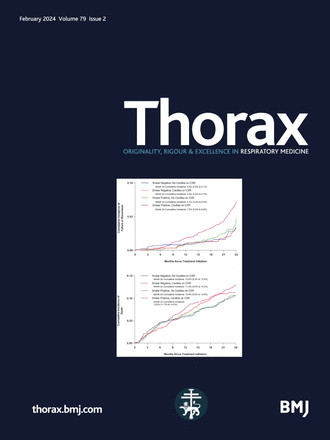Journal club
IF 9
1区 医学
Q1 RESPIRATORY SYSTEM
引用次数: 0
Abstract
Treatment recommendations for primary spontaneous pneumothorax (PSP) have changed significantly in recent years. The latest guideline by the British Thoracic Society (BTS) has shifted towards ambulatory and conservative management, following the publication of two robust randomised controlled trials (RCTs). Keijzers and colleagues have published a further post-hoc analysis from one of these RCTs, demonstrating that conservative management can safely treat a large primary spontaneous pneumothorax (European Respiratory Journal, 2024; DOI: 10.1183/13993003.00429–2024). This study used the Collins method to determine the size of the pneumothorax. Patients with a sum of interpleural distance>16 cm, equating to≥80% collapse, were defined as having large/complete collapse, and patients with an interpleural distance of 6–16 cm, equating to 32–80% as having medium (<80%) collapse. The primary outcome for conservative vs intervention (radiographic resolution at 8 weeks) was 71% vs 95% in large/complete, and 87% vs 93% in medical-sized pneumothorax (OR 1.8 vs 4.5, P-interaction: 0.10). Adverse events were higher with intervention (41/154) than with conservative (13/162) management, but where not statistically significantly different based on pneumothorax size. This study showed that most patients with a large/complete pneumothorax allocated to conservative management recovered symptomatically and radiographically with shorter hospital length of stay (0.8 …期刊俱乐部
近年来,原发性自发性气胸(PSP)的治疗建议发生了很大变化。在两项可靠的随机对照试验(RCT)发表后,英国胸科学会(BTS)的最新指南已转向非卧床保守治疗。Keijzers 及其同事发表了对其中一项随机对照试验的进一步事后分析,证明保守治疗可以安全地治疗大面积原发性自发性气胸(《欧洲呼吸杂志》,2024 年;DOI: 10.1183/13993003.00429-2024)。这项研究采用柯林斯法确定气胸的大小。胸膜间距离总和>16厘米(相当于塌陷≥80%)的患者被定义为大/完全塌陷,胸膜间距离为6-16厘米(相当于32-80%)的患者被定义为中等(<80%)塌陷。保守治疗与干预治疗的主要结果(8周时的放射学分辨率)分别为:大型/完全型气胸的71%对95%,医源性大型气胸的87%对93%(OR 1.8对4.5,P-交互作用:0.10)。干预治疗的不良事件发生率(41/154)高于保守治疗的不良事件发生率(13/162),但根据气胸大小的不同,不良事件发生率在统计学上没有显著差异。这项研究表明,大多数接受保守治疗的大气胸/完全性气胸患者在症状和影像学方面都得到了恢复,住院时间更短(0.8 天)。
本文章由计算机程序翻译,如有差异,请以英文原文为准。
求助全文
约1分钟内获得全文
求助全文
来源期刊

Thorax
医学-呼吸系统
CiteScore
16.10
自引率
2.00%
发文量
197
审稿时长
1 months
期刊介绍:
Thorax stands as one of the premier respiratory medicine journals globally, featuring clinical and experimental research articles spanning respiratory medicine, pediatrics, immunology, pharmacology, pathology, and surgery. The journal's mission is to publish noteworthy advancements in scientific understanding that are poised to influence clinical practice significantly. This encompasses articles delving into basic and translational mechanisms applicable to clinical material, covering areas such as cell and molecular biology, genetics, epidemiology, and immunology.
 求助内容:
求助内容: 应助结果提醒方式:
应助结果提醒方式:


